This post is about evolution, the impossibility of the Neo-Darwinian view of it, which posits that random mutation coupled with natural selection is the main (read ‘only’) driver of morphological change; change that over time will lead to the formation of new species.
It’s the notion that randomness has anything to do with the process that I will take issue with.
My reason for doing this — in spite of the horrendous times we live in, in terms of other matters that may seem of greater importance, i.e., the underlying truth of the ‘COVID pandemic’, the actual roots of the war in Ukraine, the apparent breakage of the laws of physics by the Musk ‘space program,’ the coming cosmic catastrophe (likely via a solar outburst), and on and on — is because all the above issues find their roots in untruths (what we are told), most of which being conscious prevarications, at least on the highest levels of authority, a.k.a. ‘the PTB’, and they all, every one of them (the untruths), find their roots in the materialist worldview that mainstream science/the media/the ‘official’ culture is wedded to, which worldview depends largely on Neo-Darwinism for its justification.
(To sum up this worldview, and I’ll bowdlerize Carl Sagan to get quicker to the point: Matter and energy are all there is, ever was, or ever will be, i.e., if you can’t see it/measure it, ‘it’ does not exist; no ESP, no consciousness separate from the meat computer between our ears, no spirituality, let alone ghosts, demons, angels, and so on; especially, no ‘intelligent design’; anything you can see or touch in any way got here via a physical chain of observable cause and effect. No exceptions. When there is evidence to the contrary — just one example being the statistically proven and Pentagon-paid-for phenomenon of remote viewing, an aspect of ESP — it is ignored.)
The above parenthetical re cause and effect is especially, urgently, the case regarding the emergence of our species, or any species, leaving Neo-Darwinism the only scientific game in town, according to the ‘accepted’ definition of ‘science.’ So it would seem to follow that were Darwin (natural selection based on random mutation) to be debunked, the materialistic house of cards would fall, at least for those whose meat computer is properly functioning.
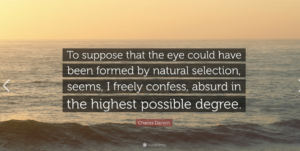 And we can simplify the means of debunking, for in 1859 Darwin himself wrote: “If it could ever be demonstrated that any complex organ existed, which could not possibly have been formed by numerous, successive, slight modifications, my theory would absolutely break down. But I can find out no such case.” (My emphasis)
And we can simplify the means of debunking, for in 1859 Darwin himself wrote: “If it could ever be demonstrated that any complex organ existed, which could not possibly have been formed by numerous, successive, slight modifications, my theory would absolutely break down. But I can find out no such case.” (My emphasis)
I recently stumbled across a young Richard Dawkins video wherein Dawkins explains how the animalian eye (any species) evolved by Darwinian means. Let’s see if Dawkins/Darwin stand up to close scrutiny…
Dawkins’s first words in the video are a quote from his hero: ‘To this day, the eye makes me shudder.’ Let’s examine why the eye made Charlie nervous, and in the process learn why Dawkins and Neo-Darwinism is in fact such a rickety house of cards. (I’ll refer to Neo-Darwinism as plain old ‘Darwinism’.) We’ll debunk the paradigm right here.
Dawkins goes on to posit a ‘just so’ story regarding how the eye evolved from a primitive ‘single sheet of light sensitive cells,’ in doing so unknowingly revealing a profound weakness in the Darwinian view, doing for the eye as his hero (and all his philosophical descendants, i.e., the Neo-Darwinists) does for the emergence of life itself: He just ‘hand waves’ the start of the process, as if no explanation is necessary as to where the sheet of light sensitive cells came from in the first place.
But for now let’s give him his premise, i.e., the (magical) appearance of a sheet of light sensitive cells on this primitive creature (although unnamed in the video, presumably a flatworm of some kind).
Dawkins (with a studio audience mostly of children), doesn’t waste any time in inadvertently exposing Darwinism’s essential weakness. About 40 seconds in he points to a video camera he’s set up, along with a projector and screen (late 20th century inventions), and tells the kids that ‘…We will see what this primitive animal would see.’
‘This animal,’ Dawkins immediately goes on, ‘with hardly any eye at all, would at least be able to tell the difference between light and dark… light and dark,’ meanwhile pointing his flashlight at the TV image, which indeed is lighting up and darkening on cue.
As if to avoid giving the viewer time to study his evolutionary faux-tableau, Dawkins Immediately jumps ahead to ‘the next stage in evolution,’ as if there is no need to explain the unwarranted, bizarre even, biological/teleological/logical/you-name-it error he’s just subjected us to (not to mention the impressionable young kids in the studio).
Don’t get it? Not to worry. Hardly anyone sees the problem here; we are that used to anthropomorphizing when we talk about other creatures. A hint: it’s the verb in the above Dawkins-sentence that gives the game away… ‘Tell’… ‘tell the difference.’
No? Still don’t get it?
Dawkins is putting himself in the place of the flatworm, which does not even possess a brain! With his knowledge of what sight is, what it means, Dawkins is making an error we all tend towards, notwithstanding the profound ignorance of how the biological world really works it reflects; here, in the assumption that a brainless flatworm can process information at all, let alone to the same degree as a human.
Recall that for Darwinism’s random mutation/natural selection to work at all, a mutation, any mutation, must have selective value, i.e., it has to somehow, either through morphological change (strength, speed and so on) or through a change in behavior, make survival and/or reproduction more likely. In this case it’s presumably the latter, i.e., a change in behavior, that is the issue: According to Dawkins and his fellow Darwinists, the flatworm, ‘sensing’ where the light is, moves either towards or away from it, depending on which is ‘better’ for its well being.
Again, I ask: What does Dawkins mean when he claims the animal will be able to ‘tell thedifference’ between light and dark? The mere presence of light sensitive cells will not ‘tell’ the animal anything unless it is connected to its (very primitive) nervous system. And that nervous system would have to be connected to its means of locomotion, if there is to be a change in behavior, said change of behavior being the sin qua non for natural selection to occur. This would require added, simultaneous, mutations (at least two more, probably several).
Although there is more on mutation frequency to come, once you need more than one (mutation) to occur simultaneously you get into prohibitive odds. For example, the chance of a one-in-a-thousand mutation is… 1/1000, right? If you need two the odds change to 1/1,000,000, one-in-a-million. Not likely, right? One more (three in total) gives us one in a billion. Point being that if more than one mutation is needed to give the desired effect, the odds are not good. (The above mutations are likely less probable than 1 in 1,000, although, as I will point out, there is no way of knowing the actual odds.)
Here the Darwinists will all shout in unison their conceptual crutch… ‘Time!’ All we need is enough time and any odds can be beaten, they’ll claim. Or as Dawkins is wont to repeat over and over: ‘Gradual, gradual is the change in evolution.’
When the odds are one in a billion… but okay, for the sake of argument, let’s give them the needed mutations.
Even then — even if impossible odds are beaten and the several needed simultaneous mutations do occur — the animal would have to learn, by trail and error, in which direction it’s better (to its advantage) to move, towards or away from the light. Which begs some questions: How often is an incorrect reaction fatal, necessitating that this improbable process start over again with another one-off mutation in another individual?
Addendum: It’s important to keep in mind that this process is based on ‘one-off’ mutations, i.e., a random change in a single individual, living somewhere here on earth.
Although the subject of trait fixation is for another essay, I would point out that if the idea of a single mutation (a sheet of light sensitive cells) in an individual flatworm spreading to every individual flatworm on planet earth sounds preposterous, that’s because it is preposterous. (Or at the very least, wildly, profoundly inefficient.)
That an organism suddenly equipped with any sort of visual sense would have to learn what light means is never brought up in the eye evolution debate. I believe the reason for this is that it’s just so flat in our faces, a forest for the trees kind of thing. Even the bright folks at the Discovery Institute seem to have missed this crucial question: Is an animal without a brain capable of this sort of operant learning?
How many times would it have to survive a ‘mistake’ to start learning ‘what the light means’? What are the survival/fitness numbers here, the odds?
Addendum: More questions for Dawkins: How often does a mutation that creates a light sensitive sheet of cells occur? Does it ever occur? Has it ever been observed in a laboratory experiment? Has this experiment ever even been done? Since the answer to the last two is No: Isn’t this (random) process nothing more than pure (and wildly improbable, statistically) speculation? The most fanciful sort of ‘just so’ story?
Here’s how Dawkins would almost certainly answer (I’ve heard him answer similar questions thusly): It must have happened this way because the eye exists. This of course reflects a tautology in thinking, circular reasoning, i.e., assuming to be true that which is at issue. In other words, balderdash.
Sub-addendum: Darwinism, its ‘survival of the fittest’ paradigm, is built upon circular reasoning to begin with: They define ‘fitness’ based on survival, and vice versa. Even Wikipedia admits this:
‘Some philosophers and scientists have suggested that the notion of survival of the fittest is an example of circular reasoning—that is, a tautology (a statement framed in such a way that it cannot be falsified without inconsistency). In tautologies, any true statements that follow are a matter of definition.’
A bit later in ‘the process of evolution’ Dawkins has a young girl stick her face in front of the ‘primitive animal’s eye’ (again, a 20th century TV camera and projector) and says, ‘This animal can even see what his predator’s face looks like!’
Dawkins is now assuming that this brainless creature knows what a face is. (Frankly, it’s unbelievable that this man has a Ph.D. in… anything… )
Addendum: Here’s a list of Dawkins verbs used in the 15 minute video: ‘Tell (the difference)’, …’tell the direction (a predator is coming from)’… ‘this animal now has a very good idea’ (!)….’is able to see what kind of a predator it was’… ‘now I could see my predator in some detail (how does it know it’s a predator? Presumably when the predator eats it…but that would cancel… ahh, never mind)… ‘all the dramas witnessed’ (by the flatworm)…
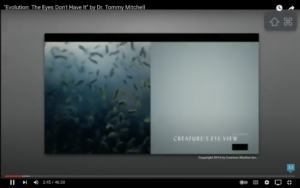
In this video, de Grasse Tyson tells us how a flatworm perceives the world, i.e., not quite as clearly as we do.
I went through every Youtube description of eye evolution and every one uses verbs like ‘tell (a difference)’, ‘know’, ‘discriminate’, ‘have a very good idea’, ‘is able to see’, and so on, in describing the ‘state of mind’ of whatever primitive creature they are assuming is equipped with light sensitive cells.
Some of the guilty are: De Grasse Tyson, Prof. Eugenie Scott, Sir Richard Attenborough, Bill Nye (the science guy!), Stephen J. Gould, Liam Neeson (as if he knows anything), any BBC narrator, even physicist Larry Krause, apparently not satisfied with public displays of his ignorance regarding cosmology… and on and on…
According to Dawkins, Swedish professor Dan Erik-Nilsson calculated how long it took for the eye to evolve from a sheet of light sensitive cells. My curiosity piqued, I found a lecture on eye evolution by Nilsson and got through it. Professor Nilsson indeed knows his eyes! He may just be the top Eye Guy on the planet! Problem is, he too is unable to see the forest, what with all that wood in the way: Like the rest of the Darwinist crew, he gives microscopic organisms the ability to reason.
But I did learn some cool eye stuff from the Professor, like about the near-miraculous opsin molecule, which is the basis of all vision, based on its light sensitivity. I tucked away this nugget as the Professor droned on until he eventually got to his calculation of how long evolution took to come up with a fully formed eye: According to his computer program, 363,894 generations, with an (average) estimate of one year for each generation, and the assumption that each mutation accounted for 1% of what was needed, making the time lapsed from opsin sheet to eagle eye (say) easy to calculate (363,894 years, to be exact).
Although Professor Nilsson didn’t go into great detail about the genesis of his computer algorithm, I pretty quickly understood its essential weaknesses, one glaring example being an issue I’ve already mentioned, i.e., the Darwinist failure to calculate the rate of occurrence of the first (and utterly vital) mutation, which, they say, resulted in a sheet of light sensitive cells appearing on a primitive creature’s outer membrane (skin).
Addendum: I also found myself zero-ing in on the above ‘1%’ figure, sensing it was plucked out of thin air, and was hence a reason for Nilsson’s reticence in talking about his algorithm. As we will see, there are at least three relevant numerical values that he cannot, likely in principle, know.
Sub-Addendum (I apologize if I’m beating a comatose horse): As I often do while viewing a video lecture like Professor Nilsson’s, I imagined myself in the audience and raising my hand.
Professor Nilsson: Yes? You have a question?
Me: How often does mutation result in light sensitive sheets showing up on a primitive organism? A number, please.
Professor Nilsson: Uhhhh, I don’t have any idea.
Me: Then your number, 363,894, is complete fantasy, right?
or…
Professor Nilsson: Uhhh…
Me: If by some… uh… miracle… a sheet of light sensitive cells does show up on an individual, how does that change the organism’s chance of survival/reproduction? A number please, since you came up with one (number of generations/years to evolve an eye).
Professor Nilsson: Uhhh…
And so on.
I’ve searched and found no study that looks into the matter of opsin sheet appearance via mutation. Astounding, no? I mean given that — according to all the big shot Darwinists on the planet — opsin is the key to all vision, one would think that there would be some curiosity about how often it might pop up in primitive organisms. Or, more importantly, even if it ever pops up. According to Dawkins (et al.), evolution is an ongoing process, even to this day, so why not give this a look?: The evolution of the eye is a subject that, since the time of Charles Darwin, has been near center of the debate over the creative power of natural selection.
And this type of study is not unheard of, one example being the ‘Lenski Experiment.’ According to Wikipedia:
‘Thirty years ago the world’s longest running evolution experiment began when scientist Richard Lenski seeded 12 identical flasks with E. coli bacteria. Every subsequent day someone in the lab has transferred a sample of each flask into a new flask and every 75 days a sample is frozen acting like an evolutionary time capsule.’ (end of quote)
Lenski’s still on-going study has currently examined the mutations in over 70,000 generations of E. coli.
Something like Lenski’s experiment could be set up using a flatworm-like organism with a fast reproduction rate, using an automated means of detecting the presence of opsin molecules. Since flatworms are so small and reproduce so quickly, a handful of aquarium-sized containers would house millions. Given the ongoing controversy over eye evolution, why has this never been done? Darwinists would likely use their standard excuse: Evolution takes millions of years, so we just don’t have the needed time. To which I say: Richard Lenski solved that problem, so why don’t you?
I suspect this has not been done because Darwinists (subconsciously?) know that they wouldn’t produce any light sensitive sheets no matter how long they carried on.
But let’s assume, for the sake of argument, that they did find one. Bingo! A flatworm (type organism) with a light sensitive (opsin) sheet! This brings up the next question, which Professor Nilsson cannot possibly have answered in his 363,894 generation conclusion. And we’ll even assume the preposterous notion that simultaneous mutations gave the flatworm a connection from the opsin sheet to its nervous system and thence a connection to its means of locomotion, so it can take advantage of its newfound ‘knowledge’.
The question is: What would be the selective advantage of the opsin sheet, and, since we’re aiming at a number (363,894), we need a number here. In other words, to what numerical degree will flatworms with the above adaptation survive to reproduce, compared to its brethren without such? Obviously, with only one (hypothetical!) example at our disposal, no such number is forthcoming.
Let’s call this number the ‘fitness percentage’. (Selective breeders call it ‘selection intensity’, which I avoid because it is misleading. That I had to concoct the term as it applies to natural selection [as opposed to selective breeding] rather than look it up says something about what Darwinists want to avoid discussing.)
Since no such experiment has been done, and since we’re talking in hypotheticals, for now the fitness percentage will have to be defined as ‘undefined’. If a number in an equation is undefined, doesn’t that make the equation meaningless?
Indeed, since the two most important numbers needed (rate of mutation and fitness percentage) are impossible to know, how did Professor Nilsson come up with the exact figure of 363,894 generations/years?
Even given his (fanciful) premises, he is likely off by orders of magnitude, and likely not in the direction of ‘ease’. But there is no way of knowing, is there? (Here’s a link to Nilsson’s paper. See if you can figure it out.)
Physicist Wolfgang Pauli’s wonderful ‘You’re not even wrong’ zinger comes to mind.
#
‘An eye on its own is a rather useless thing,’ Professor Nilsson informs us, later in his video lecture. ‘Unless you have a brain behind it… a nervous system that can generate behaviors.’
He goes on: ‘Visually guided behaviors must kind of be there first, then selection will act on the visual organs. Primarily [eye evolution] works on visually guided behaviors…’ (my emphasis)
Predictably, Professor Nilsson, after dropping the above conceptual bomb, immediately changes the subject without explaining how the dilemma is resolved. He is in fact referring to my above point that a ‘sheet of light sensitive cells’ is evolutionarily useless unless it is connected to a nervous system that ‘knows’ what light means, and, further, the organism must be capable of acting on that knowledge — moving towards or away from the light it ‘sees’; absurd assumptions on their face.
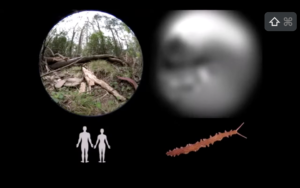
A flatworm ‘sees the world’ just like us, only a little fuzzier, according to Dawkins/Nilsson/et al.
I’m quite sure that Professor Nilsson, if pressed, would answer in the Dawkins manner: Since eyes exist, It must have happened that way.
This is the only ‘reasonable’ Darwinian response, given that the alternative would be some sort of guidance, a.k.a. intelligent design, which is the biggest no-no of all in the Darwinian paradigm.
The above chicken-and-egg dilemma is similar to the problem of the appearance of life itself, another sore subject for the Darwinists, since they have no idea how it could have happened, and for the same reason the appearance of the eye is so problematical: It’s a matter of the numbers, the odds against the efficacy of a purely stochastic (undirected) mechanism when you need simultaneous occurrences, chemical in the arena of life’s appearance and mutational when we look at eye origins.
Addendum: A reminder: The numbers that are not known (because in practice they cannot be known), in the matter of eye evolution are the following:
- Rate of mutational appearance of opsin sheets on the outer membrane of a primitive organism, along with connections to the nervous system and means of locomotion: Multiple/simultaneous mutations.
- Number of generations needed for the organism to ‘learn’ what ‘light means,’ assuming this is even possible. Without this step there can be no selective advantage.
- To what extent numbers 1 and 2 contribute to the survival/reproduction potential of the organism.
- How many generations it takes for each mutation along the pathway to the eye to replace every individual without that mutation. (The italics will, hopefully, get you to really think about this! The problem for me is that thinking about it makes my head hurt. If it does the same to you, don’t blame me. I’m not telling you that the first thing that happens in the process of evolution is a random event.
Sub-Addendum: Regarding number 1 above, I spent a full day scanning various studies, trying to get a sense of what the Darwinian research says. When it came down to specific mutation rates (pick a trait!) I came up empty. The best I could find was the most arcane sort of mumbo-jumbo/hand waving. Like this:
In one of the first attempts to understand the patterning of mutation rates across various organisms, Drake (1991) concluded that the mutation rate/nucleotide site/generation (u) scales inversely with genome size (G) in DNA-based microbes, which further implies that the mutation rate/genome/generation (uG) is essentially constant across all microbial life. Because this early analysis was based on just seven taxa, four of which were bacteriophage, there was room for skepticism over the initial findings, but additional mutation rate assays performed in recent years have allowed for a substantial extension of this previous analysis. Although most microbial mutation rate estimates still rely on single reporter constructs, the approaches advocated by Drake (1991) can be used to translate per locus rates to a per nucleotide site scale (Supplemental Material). The focus here will be on base substitution mutations alone, as considerably less work has been done on insertions and deletions.
Sorry to have put you through that, but this is what you get if you try to pin a Darwinist down regarding how his brand of evolution works, i.e., starting with a random event.
The question they do not want to hear is, How does that actually work in practice?
#
Okay, let’s take a different tack and for the sake of fairness (in avoiding specific processes) we’ll go along with Dawkins’s anthropomorphizing. Imagine this: You wake up one morning with the one-off mutation of a radiation-sensitive sheet of cells, say, on the back of your neck. You can’t see it, feel it (because it is not attached to your nervous system), so you are unaware of it. But it’s there.
Now, the question is, how would the radiation-sensitive sheet affect your behavior?… Not at all is the obvious answer, since your learning anything is out of the question.
Hence the mutation could not possibly be of selective advantage.
Addendum: In a past post I took this sort of anthropomorphizing one step further and did some research into what happens when a person born blind is suddenly able to see, a circumstance analogous to Dawkins’s just so story of a light sensitive sheet suddenly appearing on a flatworm type organism.
(For those interested in the details, here’s the URL to the post, which is partly my correspondence with New York Times science writer Carl Zimmer, who failed in answering any of the points I’ve made here; he just ignored them. When I pointed out the astronomical odds against simultaneous mutations, Zimmer responded by saying they don’t need to be simultaneous, an incredibly ignorant statement, considering its august source.)
Suffice to say for now that the born-blind folks were unable to discriminate between objects (‘tell the difference,’ in Dawkins’s terminology) even though they’d been told (by doctors and loved ones) what would they would ‘see’ when the bandages came off.
Darwinism apparently implies that a flatworm can do better than a human in this sort of situation.
Dawkins, in his video (for laughs, now’s the time to view it!), compares evolution to climbing ‘Mount Improbable’ — one step at a time and voila, you’ve done it! — then, mixing his metaphors, he tells us that ‘An eye could evolve at the drop of a hat.’
Since, without missing a beat, Dawkins also tells us that evolution is ‘gradual gradual, over billions of years,’ we might respond that he can’t have it both ways, hat dropping and billions of years.
Professor Nilsson is on the same page as Dawkins, telling us that, in practice, ‘The eye could evolve many times in the 363,894 generations I give it.’
Both Nilsson’s and Dawkins’s claim about the ease of eye evolution is based on nothing but wishful thinking, since they cannot explain how anything works, specifically, let alone come up with the defining numbers, as above. Regarding their computer algorithms and their logic, it’s ‘garbage in, garbage out.’
Since Dawkins, Nilsson, and indeed any Darwinist, tell us the eye evolved many times since the beginning (‘convergent evolution’), forty being the current estimate — with about a dozen being the number of ‘paths’ to a workable eye — let’s briefly look at a related eye-issue, which I believe — like the above points — is not obvious for the same forest-for-the-trees reason, and we’ll start by stating the Darwinist premises:
- Mutations are random.
2. Evolution has no foresight and no memory (it cannot ‘aim’ at an outcome or ‘refer back’ to what it has done in the past).
3. There are somewhere around a dozen evolutionary paths to functional eyes.
Then how did binocular vision form, with both eyes being identical in structure?
You may be thinking that of course any two eyes are the same. It would look weird if they were not.
Tell that to Dawkins, Nilsson, and their ilk, for they would insist that evolution could not know what path (out of a dozen) one eye took, or is taking, while the second eye develops. Evolution has no memory and no foresight.
But it’s not just 1 in 12 that the two eyes would somehow be identical, but 1 in some gargantuan number, since each species’s set of eyes is unique to that species.
Admittedly, getting a Neo-Darwinist to admit this is problematical, since you pretty much have to put a gun to their head to get them to be specific about how any organ or trait evolved. (Also, believers in undirected evolution do not deal with the question of symmetry.)
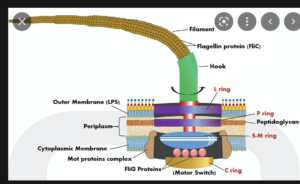
A bacterial flagellum. Ask a Darwinist about a possible first mutation leading to this complex organelle and see what he says. (It has to be a ‘tiny’ change that is noticeably advantageous.)
Addendum: Look at the other evolution poster child (thanks to Dr. Michael Behe’s seminal book, Darwin’s Black Box), the bacterial flagellum, and try to get a Darwinist to posit what might have been the first mutation leading to its creation. (As the Darwinist is going on and on about ‘co-option of a secretion system,’ stop him and suggest he postulate the first mutation leading to the creation of a secretion system. He won’t do that either.)
Even with ‘just so’ stories, when you ask a Darwinist to get specific he will inevitably avoid the issue, fearing he’ll get stuck in a chicken-and-egg dilemma, which he tends to do… at the drop of a hat.
Addendum: In case you’re not aware, the term ‘Just so’ story is from Rudyard Kipling’s book of the same name (to be accurate, Just So Stories), a charming compendium of tales for kids on how, for example, the leopard got his spots. Here’s a link to an audio version of this one; it’s worth a listen, not only for its similarity to Darwinist yarns, but for why such preposterous tales are so easily accepted, even by the intellectual elite, like C. Zimmer (although Dawkins’s balderdash is not nearly so charmingly crafted as Kipling’s). .
The bottom line, from my point of view: Evolution happened, no doubt about that. Otherwise we would have to account for one miracle for each species that ever existed (hundreds of millions in total). But the idea that randomness has had any part in it, is not only unintuitive but downright stupid and ignorant.
It follows that the materialist/reductionist/ scientism worldview is, by definition, bunk. Period. And since the worldview of 90% of working scientists is materialist, it follows that it’s no wonder they get so many things so fundamentally wrong. Which they do.
I’m working on a list.
Allan
You can go here for a different take on why the Nilsson study is balderdash.

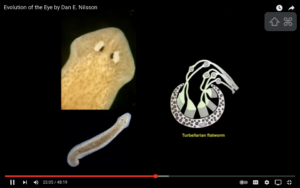


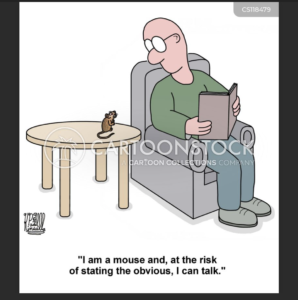
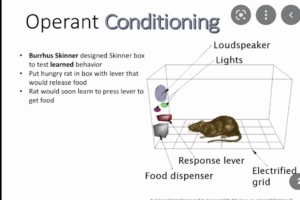
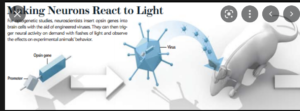

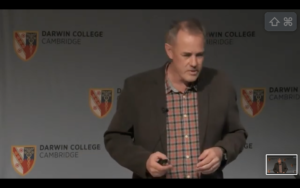



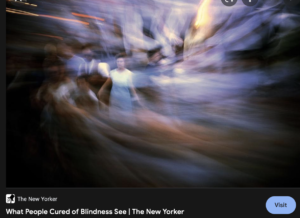



31 comments for “The Dawkins/Kipling Dilemma”